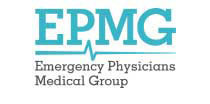CASE STUDY
Emergency Physicians Medical Group
Charting a Path to Better Emergency Department Performance and Productivity
EPMG uses d2i’s cloud based analytics to increase visibility, accountability and overall performance in the ED at St. Joseph Mercy Ann Arbor. Using d2i, EPMG is controlling costs and creating a measurably better patient experience marked by shorter turnaround times, fewer walk outs, and a reduced number of 72-hour ED returns.
The 60 physicians and nurse practitioners of Emergency Physicians Medical Group (EPMG), a division of EmCare, handle more than 89,000 ED visits each year at St. Joseph Mercy Ann Arbor in Ann Arbor, Michigan. EPMG chose d2i’s data analytics platform to gain faster, better visibility to benchmarks and key performance indicators that keep patient satisfaction levels high, and the cost-of- care under control.
Dr. Kathryn Volz is calm and determined when she talks about the unending quest for continuous improvement in patient care and outcomes. It’s the demeanor you’d expect from an Emergency Medicine physician who must be able to switch from scrapes and scratches, to Level I trauma cases, in a matter of minutes.
As the Assistant Medical Director for the Emergency Department at St. Joseph Mercy Ann Arbor, Volz is responsible for monitoring factors that impact quality and cost. She’s a physician first, but she also has a keen interest in the power of data transparency and how it can inform and inspire better care.
EPMG uses d2i as its cloud-based quality and performance metrics platform.
“Great providers are the foundation of our care, but we also invest in great tools to help us get better,” says Volz. “d2i keeps our five most important metrics front and center: length of stay, admission rates, patients per hour, CT scan utilization, and turnaround times. If you can measure it, you can manage it and d2i makes it easier to do both.”
Data Plus Meaning Equals Better Care – at a Lower Cost
d2i extracts detail clinical and operational data from Trinity Health’s EHR for St. Joe’s using custom scripts and integrates it with billing, hours and satisfaction data. Data is cleaned, normalized and formatted and available through a browser.
“I can access our d2i performance dashboards from anywhere, which makes it easy to share how we’re doing at a glance with other stakeholders,” says Volz. “We also have the ability to share de-identified patient and provider data broadly so providers can see where they stand compared to their peers and make adjustments on their own. Peer comparisons get the competitive juices flowing in very positive ways.”
Each Monday, Volz and her colleagues review the latest metrics, looking for variations that might require additional discussions.
“The data gives us important clues and reveals patterns that we can learn from and adjust for,” says Volz. “We can’t fix things or improve on them if we don’t know what they are. D2i shows us exactly how we compare to each other, as well as national benchmarks.”
Access and transparency of health care data are powerful drivers of health care improvement.
A recent report by international consulting powerhouse McKinsey & Company found that “…public data reporting is as effective an incentive as financial rewards in convincing providers to improve their clinical performance.”
But it’s difficult for providers to objectively evaluate the quality of care at the time it’s delivered. The implications of certain decisions sometimes take hours or days to reveal themselves.
Turnaround times and admission rates are hard to judge during a shift, but when they are reviewed over days and weeks, subtle patterns emerge; some good and some not.
“Visibility and accountability drive better care,” says Volz. “Patient comfort and professional pride are powerful motivators. We all want to do our best at all times for our patients and ourselves.”
Setting Performance Goals – and Achieving Them
Volz and her colleagues have specific targets for key performance metrics for the ED at St. Joseph Ann Arbor. “Walkouts”, or those who leave before being seen, are of great concern because it likely means that waiting times were too long. Identifying the various and related factors that can lead to walkouts requires data and a tool specifically built to provide answers.
“We’re always interested in provider productivity,” says Volz. “Patients per hour, turnaround times, and severity of cases tell us if we’re striking the right balance of appropriate coverage. Patients need to be seen in a timely manner, and staffing is one of our biggest expenses. d2i helps us be smarter about it.”
Expensive tests and diagnostics like MRI’s and CT scans also add up quickly. Most of the time, these tests are critical to making a good diagnosis. Sometimes the severity – or lack of severity – may make them hard to justify. Having a tool that tracks compliance and utilization of services can help practice variability that could lead to poor outcomes and risk.
“We’re not driving care based on expenses, but our d2i reporting does remind our physicians and nurse practitioners to be thoughtful about orders,” says Volz. “Cost is compared to quality and outcomes now, so we’ve got to know our numbers if we’re going to improve them.”
Volz says cost and quality conversations are a part of health care delivery now, and their importance is only increasing. But make no mistake, d2i is only a means to an end, not the end.
“Over the last four years, d2i dashboards have become vital management tools in our continuous improvement efforts,” says Volz. “The bottom line is when we get better, faster, our patients get better, faster. And that’s what counts.”
Take Action on Your Data
Would you like to work with a company that shares your passion and commitment to increasing the performance and profitability of your ED? See why no other health care business intelligence application or EHR system even comes close. Contact d2i for more information about how we can help you, or to schedule a 30-minute demo.

Annual ED Visits:
EHR System
Trinity Health
Solutions
d2i’s ED Performance Dashboard